The Gorilla 8007 Motorcycle Alarm
The Gorilla 8007 Alarm system is basic on features and offers good (or loud) bang for the buck.
Its simple and straightforward design make installation easy once it is determined where to locate the system.
Motorcycles come and go for many owners.
The reasons vary; a new bike means the old one must be sold or perhaps a crash has rendered the old one un-fixable.
The worst reason for a bike to go, however, is because someone else wanted it enough to steal it.
I recently purchased a 2006 Triumph Sprint ST 1050 and my Suzuki SV650s had to go, so for me it was for the former and luckily not the latter.
I have been fortunate enough not have experienced the anger and frustration of having a motorcycle stolen and hope to keep things that way.
To that end, I’m willing to take extra steps necessary to deter would-be thieves from considering my bike as a potential target.
Preventing Motorcycle Theft
When discussing motorcycle security, one thing most people will agree on is that if someone wants to steal it bad enough, they’re going to find a way.
Often the best thing you can do is make your ride a less attractive target than others.
For example, if a thief spots a flashing red light on the fairing panel, indicating an alarm system or immobilizer is active, they might keep looking for a bike without one.
Other steps, such as a disk lock and/or chain, can also help make your motorcycle less attractive to those looking for an easy mark. But today we’re discussing a motorcycle alarm system.
I had installed a Talon T-3300 alarm system (review) on my Suzuki SV650 after reading he webBikeWorld review.
I would have purchased another Talon system for my Triumph, but unfortunately Talon Motorcycle Alarms seems to have closed up shop.
What I liked about the Talon T-3300 was its comprehensive feature set and low price. In addition, Talon offered wiring kits that made installation on many modern motorcycles a plug-and-play experience.
Without Talon to consider, I didn’t find any alternatives that fit my budget and had the same or similar feature set.
Something was going to have to give, and in this case a couple of “bells and whistles” lost to cost.
I have seen Gorilla brand alarm systems appear in searches over the last few years when I’ve looked at motorcycle alarm options, but for some reason never gave the more than a cursory glance.
Perhaps the $79.95 price for the Gorilla 8007 Motorcycle Alarm is what caught my attention this time while hunting down an alarm for my newest motorcycle. So what does one get for their eighty bucks? Let’s have a look.
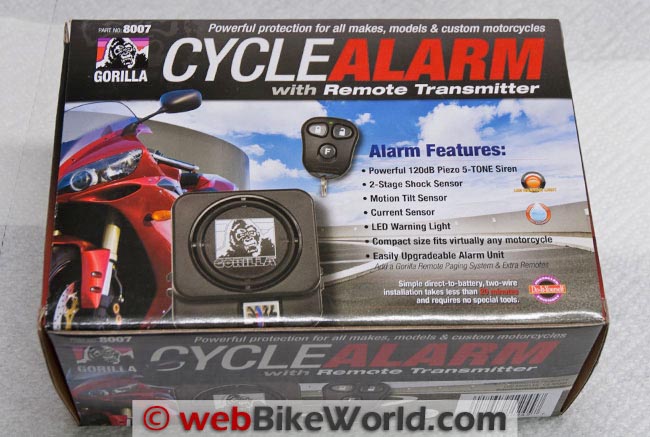
Where to Buy Gorilla 8007 Alarm
See More: Motorcycle Horn, Motorcycle Lights, Motorcycle Accessories
The Gorilla 8007 Cycle Alarm
The Gorilla 8007 Cycle Alarm is a very small system. The 8007 integrates the siren, shock sensors, and control unit into one small box, measuring just 76 mm by 90 mm by 45 mm (3 by 3.5 by 1.75 inches).
This means that it is fairly easy to find a suitable mounting location on most motorcycles.
The Gorilla 8007 alarm has three different sensors that will activate the siren: a shock sensor, a voltage sensor and a tilt sensor.
Shock Sensor
The shock sensor has seven levels of adjustability. It also has two stages that can be set to emit a warning chirp for a light bump (e.g., if someone accidentally bumps against the bike in a parking lot) or it will emit a full alert siren during a more vigorous impact.
Voltage Sensor
When armed, the Gorilla 8007 monitors the voltage of the electrical system and when sudden drops in current are detected (e.g., during a hot-wire attempt), the alarm will sound.
The shock sensor may be more practical than the voltage sensor on older motorcycles or “naked” bikes, where the wiring is exposed or easy to find.
The shock sensor will hopefully sound the alarm long before an attempt is made at compromising the wiring on a motorcycle with a lot of bodywork.
Tilt Sensor
Finally, the Gorilla 8007 comes with a tilt sensor that will set off the alarm when the bike is moved from the side stand position.
The tilt sensor is external to the main alarm unit due to the fact it does not auto-calibrate and it must be positioned in a certain way for maximum effectiveness.
The tilt sensor also comes with a generous length of wire so that it can be placed in an appropriate location.
Self-adhesive hook and loop fastener is provided to mount it which facilitates repositioning to find the optimum angle for the sensor.
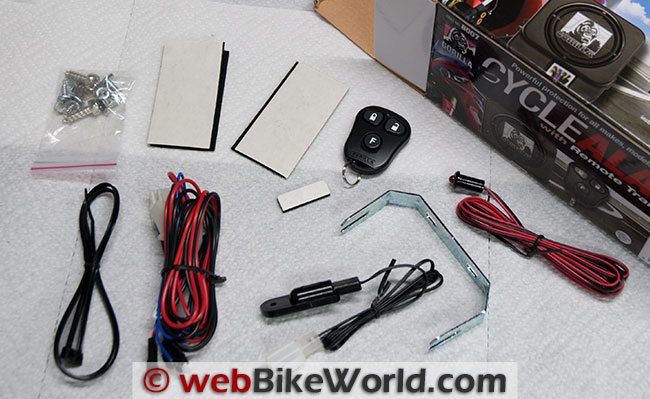
Gorilla 8007 Alarm Siren
The siren on the 8007 is claimed to be a 120 dB piezo type, and while I do not have a dB meter, I will say that the siren is very loud compared to most other motorcycle alarms I’ve heard.
Even the “chirp” that is emitted when arming the device is loud — when I tested the alarm for the first time in the garage, I was rather shocked (and a bit startled) at the volume.
Of course, location of the siren on the motorcycle will affect the audible sound output. When it is armed, the Gorilla 8007 monitors the voltage of the electrical system on the bike and when sudden drops in current are detected (such as a hot-wire attempt), the alarm will sound.
Wiring the Gorilla 8007 Alarm
The Gorilla 8007 alarm has a single wiring harness connector that plugs into the unit.
The harness has connections for power, the tilt sensor, the warning LED, and the antenna for the wireless remote. It also has a connection for the optional two-way paging system antenna.
By the way, the Gorilla 8007 alarm is identical to the Gorilla 8017 Motorcycle Alarm.
The 8017 alarm includes the two-way paging remote and antenna and it costs around $125.00. Gorilla also offers a kit (Gorilla 1018) for around $100.00 that will upgrade an 8007 alarm to the 8017 system.
The package for the 8007 as well as the Gorilla website claims that the system can be installed in under twenty minutes, thanks to the simplicity of the unit and wiring.
This claim may be accurate as far as the time spent actually mounting the main unit and connecting the wiring; however, overall time can be considerably longer.
Your “mileage may vary” so let’s take a look at the installation process to see what took me over two hours instead of twenty minutes.
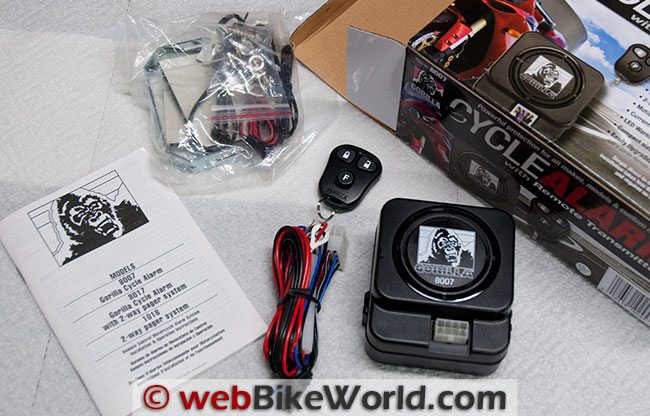
Where to Buy Gorilla 8007 Alarm
See More: Motorcycle Horn, Motorcycle Lights, Motorcycle Accessories
Locating the Alarm
My installation took over two hours to perform, not because Gorilla’s claim is incorrect about the simplicity, but rather how much time I spent planning in an attempt to make a clean installation. Here is a copy of the Gorilla 8007 alarm installation instructions (.pdf).
I also wanted to find a sturdy and secure mounting location for the alarm that would be difficult to notice when looking at the bike.
The 8007 alarm comes with self-adhesive hook-and-loop fastener pads as well as a metal bracket for facilitating installation of the alarm module. If the alarm is installed lying flat in a contained area — under a seat for instance — the hook-and-loop pads might work well enough.
Personally, I wanted to find a way to use the metal bracket to ensure a secure attachment.
A great place to install an alarm on many motorcycles is under the seat. Typically there is storage space in this location that will easily accommodate an alarm module the size of the 8007.
This location is often close to the battery as well and offers easy access to the owner while making very difficult to access by would be thieves.
On the 2006 Triumph Sprint, however, there is no space below the seat save for the battery box and even it is laying on its side, leaving no room for other items.
Moving further back under the seat is where the heat shield is for the under-seat exhaust, so even if space were available under here, the higher temperatures in this location would probably not be good for electronics.
The Sprint is a sport-touring motorcycle and, as such, it has considerable bodywork coverage and a good-sized fairing.
I assumed it would be easy to find a location under all that plastic that would satisfy my criteria of being sturdy and not easily discovered, but finding the perfect location took me a bit longer than I thought it would.
After the removal of many screws and the wedging and test fitting the alarm unit in several places, I finally found a location that would do the trick as can be seen in the photo.
At this point, I was already in for around 30 to 45 minutes of time and I had only found the mounting location for the alarm, so I already blew the “less than 20 minutes” claim.
I don’t blame Gorilla for this, but rather the unique challenges with my motorcycle and perhaps my own neuroses.
Now that I had found a position for mounting the alarm module, I attached it loosely to where it would be living and then began the process of determining the path of the wires involved.
I would need to find the power and ground (the red and black wires) the routing for the antenna remote (blue wire); the location for the tilt sensor (black wires with connector) and the location for the warning LED (the thin black and white wires with connector).
First I needed to find power and I wasn’t keen on trying to run power all the way from the battery to my mounting location.
Fortunately the Sprint is a sport-tourer and it has provisions for powered accessories, including those that remain on even with the ignition off.
In the spirit of security, I am not going to show precisely where I tapped the power from but I was able to find a nearby location providing full time power and a ground wire as well. So, with the power connection being quick and painless, I moved on to place the antenna wire.
The instructions recommend that the wire being stretched out and not wrapped around objects so as to get the best reception from your wireless remote.
I should note at this point that the included installation/operation instructions manual for the Gorilla 8007 alarm is very good.
Although it may border on being too verbose all the details are there and the manual appears to have been natively authored in English rather than having been translated (poorly) from another language.
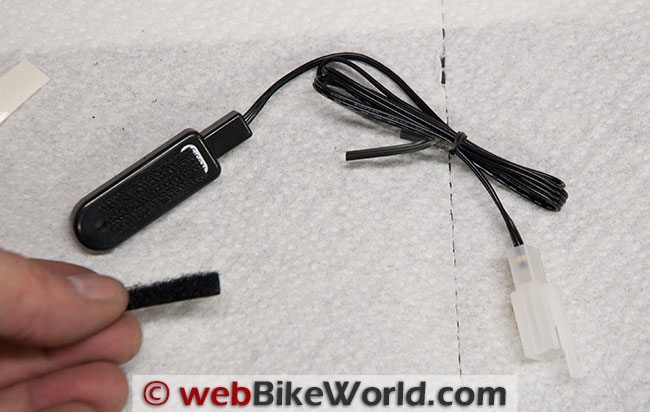
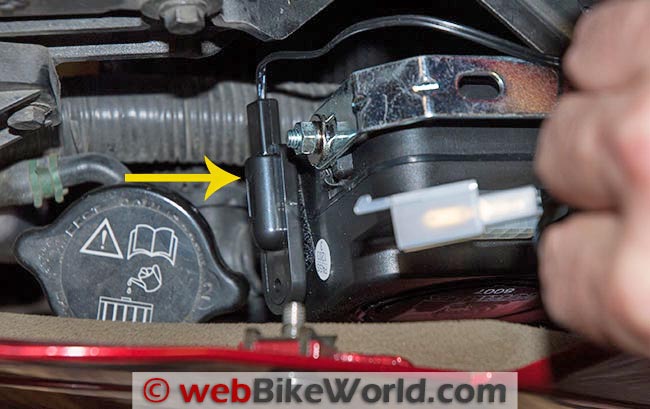
The Tilt Sensor
Moving on to the tilt sensor, it is important that this device is placed horizontally, with its wiring located to the right side of the bike.
The reason is that the tilt sensor is a simple mercury switch and when the sensor is level horizontally, the mercury will close the circuit between the two wires on the sensor.
When leaned over on a side stand, the circuit opens as the mercury falls down and to the left side.
This is not as advanced as other alarm systems that can calibrate and sense from different positions and lean angels to detect when the bike is being moved, but the 8007 has been designed to a price.
This design could prove a problem if you park your bike on a center stand.
There are ways around this though but we’ll get to that later.
The alarm module itself made a good mounting point for the tilt sensor and I used the included small hook-and-loop strips to attach it. This makes it easy to “calibrate” the sensor to activate if the bike is moved off its side stand.
Finally, the LED warning light wire needed to be connected. Actually, using the LED or the tilt sensor isn’t absolutely necessary and their absence will not affect the operation of the alarm system.
In this case, I wanted to install the LED just to give an extra indication that there is in fact an alarm on this bike. It also serves as a reminder that the alarm system has been armed.
Installing the LED is the only time where power tools and cutting are required as part of the installation process. I chose to install it into one of the inner fairing pieces that is below the left side handlebar.
The instructions suggest that an 8 mm drill bit should be used to fit the LED as a press fit.
I didn’t have an 8 mm drill bit on hand, but using the next size down and carefully moving the bit around gave me the fit I needed to hold the LED in place in the panel.
Like the tilt sensor, the LED light connects with a small harness so it can be easily disconnected if one needs to remove the panel. Now with all the wires connected and tucked away, the inner fairing panel with the LED in it can be installed.
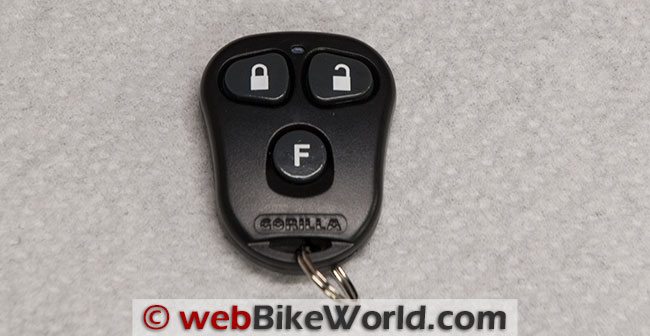
Where to Buy Gorilla 8007 Alarm
The Gorilla 8007 Remote Control
All of the functions of the Gorilla 8007 are controlled by using the included three-button remote. The remote has a button for arming, disarming, and for accessing other settings and functions.
Only one remote is included with the 8007 but additional remotes can be ordered directly from Gorilla for $16.95 each.
To arm the system, simply press the “lock” button. The system will emit one loud chirp. Pressing the “unlock” button disarms the unit and two chirps are emitted.
As mentioned earlier these chirps are quite loud so one can run the risk of annoying nearby neighbors. Unfortunately there is no way to adjust the volume of these chirps nor is there a way to silently arm or disarm the system like some other systems.
The range of the remote control is claimed to be about 100 feet, but the true range seems to be closer to about 30 to 50 feet, depending on line of sight and obstacles such as other cars between the remote and the bike.
The trick of placing the remote up under one’s chin does seem to add a few extra feet to the range. Still, the range is adequate and I haven’t experienced situations where the 30 to 50 foot range was a problem.
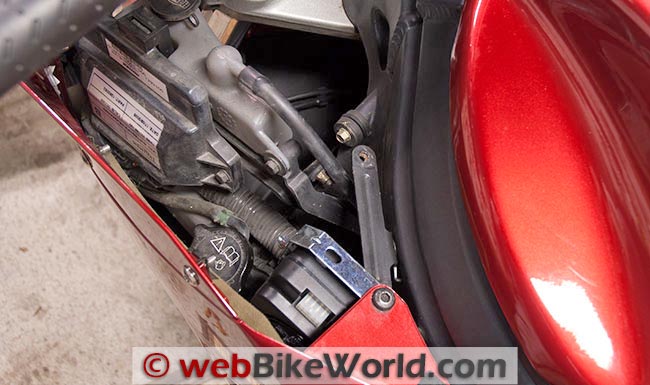
Alarm Sensitivity
The Gorilla 8007 alarm provides for seven levels of adjustment to the sensitivity of the shock sensor accessed using the remote control.
Adjustability is a nice and useful feature but in my testing I was unable to discern much if any difference between the highest and lowest setting.
I tried tapping on the bike in several places, first lightly and gradually more strongly, and in my very unscientific test it always seemed to take about the same amount of movement to get the alarm’s attention.
In this case the alarm is mounted solidly to a metal bracket attached to one of the main frame spars so shock should be adequately transmitted from various parts of the bike.
I found that a bit of extra sensitivity would be handy, as I was able to open and close my top case without setting off the alarm. If I let the lid drop it would set off the alarm.
Certainly if the case was locked, trying to break it open would set off the alarm system, and this is still better than nothing. I would still prefer an alarm that was more sensitive though.
There are two special arming modes associated with the shock sensor that can be set using multiple button presses. Pressing the “lock” button twice within five seconds will set the alarm in “warn-away” mode.
Setting off the shock sensor will only emit a warning chirp instead of the full alarm.
Pressing the “lock” button three times in five seconds will disable the shock sensor entirely for situations where the bike may be easily disturbed by equipment or parking in mulit-level garages where the floor might move from vibrations.
When set to either setting, the tilt sensor and the current sensors are still on full alert.
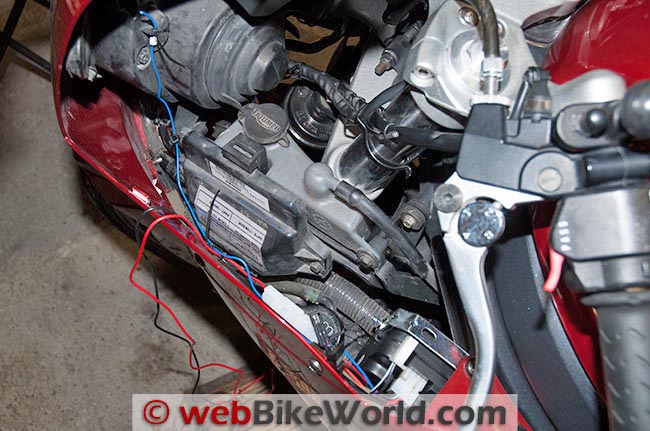
Tilt Sensor Sensitivity
The tilt sensor does work well, but getting it adjusted takes a bit of time. It appears that the sensor should be set horizontally so it becomes level when the bike is lifted off the side stand. However, the mercury inside the switch appears to need a bit more incentive to activate.
I found it best to take a continuity meter and attach it to the pins in the wire harness so that I could find the “sweet spot” without having to continually set off the alarm.
I was curious to find out what would happen if I put the bike on the center stand and then armed the alarm thinking that it might immediately go off as the tilt sensor would be tripped in that position.
Fortunately it appears the 8007 is smart enough to ignore the sensor if that circuit is closed when the system is armed.
Did I mention that this alarm is loud? During my testing I put in my earplugs as it was very uncomfortable setting the alarm tones off as well as making adjustments to the sensitivity and cycling through the various alarm tones one can select from.
This is probably the strongest aspect part of the 8007. Since so many people dismiss the sound of a car/motorcycle alarms these days, having an alarm so loud it is painfully uncomfortable to stand near makes a good deterrent.
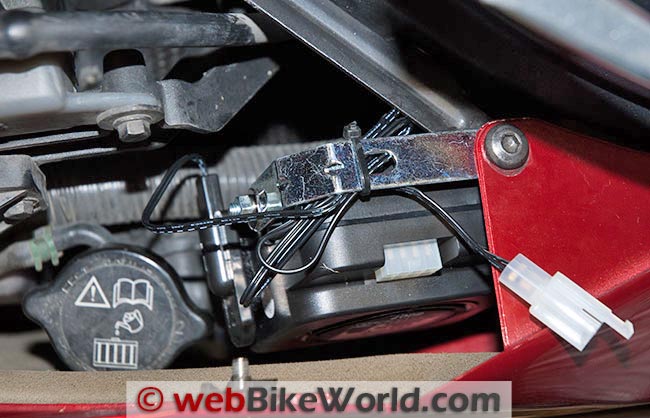
Conclusion
The Gorilla 8007 Cycle Alarm is a good basic motorcycle alarm that provides a loud warning that someone is tampering with your motorcycle.
It doesn’t have an immobilizer, perimeter sensors, or offer plug and play installation kits for specific motorcycles but it’s built to a price and the price is fair for what you get.
It would be nice if Gorilla offered additional accessories beyond the pager system, such as a perimeter sensor or a battery backup, as these accessories could make the 8007 system qualify for an insurance discount (depending on the carrier).
I still would like to see more adjustability in the shock sensor, as I was unable to detect a noticeable difference in the various settings.
But this my only complaint about the 8007.
Sure, it would be nice to have a silent arm/disarm function and the ability to have turn signals light along with the arm/disarm chirps, but offering those features would likely move the 8007 out from under the sub $100.00 price point.
|
wBW Review: Gorilla 8007 Motorcycle Alarm
|
|
|---|---|
| Manufacturer: Gorilla Cycle Alarm | List Price (2012): $129.99 |
| Colors: N/A. | Made In: Taiwan |
| Warranty: Two years. | Review Date: October 2012 |
Where to Buy Gorilla 8007 Alarm
See More: Motorcycle Horn, Motorcycle Lights, Motorcycle Accessories
Owner Comments and Feedback
See details on submitting comments.
From “B.W.” (March 2014): “I have the Gorilla Alarm 8017 (with Remote Pager). I only have one problem with it, in cold weather the shock sensor can be a pain.
After parking my bike, and letting it cool, the contracting metal would cause the shock sensor to go off.
No matter what setting I use, it gives false alarms.
My workaround is to let the bike cool down for 5 minutes, or disable the shock sensor. This happens when it’s 5C or lower. It would be nice if I could set a delayed arm feature.
Overall, it’s not really there fault, and a very inexpensive product to give you peace of mind.”
From “S.Z.” (November 2012): “The Gorilla alarm seems competent enough, but as you say, I would opt for the remote. Like your other poster here, I have the Scorpio alarm on my bike – with the pager.
However, mounting it properly I would have to tear into the tail section of my 2011 Ninja 1000 to get to the proper light wiring, etc… There was no plug-n-play wiring harness for my bike at time of purchase.
I found this to be unnecessary. I simply have it connected to the battery, which is secured under a screwed down rider’s pillion. in other words, “You ain’t gettin’ to it!”
The tilt sensor works fine, as does the adjustable shock and proximity sensor (the later seems to be only offered by Scorpio and works before the thief even touches the bike – even through my bike cover).
There is a downside to the proximity sensor; in heavy rain (or wind with my bike cover on) it goes off. No biggie. I switch the proximity sensor off and just leave the tilt/shock on.
Before I bought my alarm (and the reason I bought the alarm) I was lucky.
My upstairs neighbor works late. He came out on his balcony about 3:00 am (faces the front parking lot) to have a beer and a smoke and found some kids trying to kart off my bike!
They got it as far as behind my car, the bike cover off on the ground. He scared them away and called the police. I answered the door in a daze in my boxers.
They had apparently tried to break the steering lock, unsuccessfully, but I can feel slight stiffness in the ignition when applying it now.
I have not had one attempt in a year now with the Scorpio. Yesterday, two motorcycles were stolen just 150 feet from mine. 3 weeks ago a Harley not 30 feet away was stolen.
This apartment complex has become a haven for young hoodlums and the management is apparently doing nothing.
My downstairs neighbor is a policeman. We talk about the crime going on here all the time.
The thieves have targeted everything near me, but not mine. I’m about 20 feet from my bike to my bed, and it’s just a reach to my nightstand for my remote, and for my 9 mm.
I actually intend to get a Road-Lok for my front caliper. Between the two, my bike should be safe at night. Well between those two and my pistol. It’s a shame people think they can just take what they want. Well, not in my house.”
From “N.” (October 2012): “I had the Scorpio i600 alarm system installed on my Ninja 650r after my first motorcycle was stolen.
At first, I was a little hesitant to spend $350 on an alarm system, but the first time it woke me up in the middle of the night because someone had taken it off the side stand, I was glad I did.
If you live in an apartment complex or somewhere that the bike is parked away from where you sleep, I would really recommend springing for the model that includes the two-way pager.
Even if you don’t hear the alarm on the bike go off, placing the remote in a glass bowl with a couple pennies makes a noise loud enough to wake even a heavy sleeper.
Also, being able to look at your remote and see that your bike is still within range and hasn’t been set off gives you peace of mind.
If I were to do it over again, I’d probably just get the $150 Gorilla alarm since it comes with everything I’d need and is way cheaper. I’m glad to see you guys covering alarms though, since they don’t seem to get enough press.”

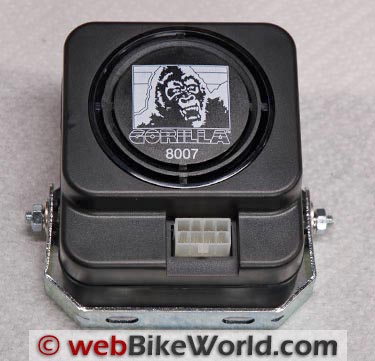

No Comment